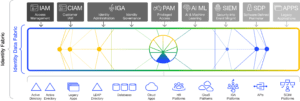Your Fabric Needs a Fabric
- The Radiant Team
- February 24, 2022
- Identity and Access Management
- 7 MIN READ

Business leaders face increasingly complex identity and access management (IAM) challenges as they deal with more remote workers and demanding customer-facing interactions. IT leaders recognize the importance of IAM both for security and the business, and are investing more in it. Nearly 70% of global business executives surveyed here said they’d increase IAM spending this year.
Yet, the high cost of deploying an IAM solution enterprise-wide can cause even the most free-spending business leader to hesitate at the expense. They must be sure they can recoup their return on investment (ROI) across the organization if they’re to invest the millions it will cost. Identity-related projects are essential, but organizations may hesitate to invest in them unless the chosen solution can do double or triple duty.
Let’s take a closer look at how an identity fabric can make a difference for advanced projects in any complex organization. Then we’ll discuss why an Identity Data Fabric is the unified identity data foundation that helps your identity fabric soar.
What is an identity fabric and why does it need an always-updated source of unified identity data?
The term “identity fabric” describes an identity management framework that delivers the capabilities needed for seamless and controlled user access to every service. It’s not a single tool, technology, or cloud application. Instead, it’s an approach for architecting IAM within enterprises. Organizations using this approach often combine a set of tools and services to deliver the major architectures they need to stay secure and competitive in a fast-moving environment.
But delivering an identity fabric securely within complex infrastructures built over years of diverse investments is easier said than done. Just like any identity-reliant initiative, you need a unified (and infinitely agile!) source of identity data to secure and enable your identity fabric, since each element that’s woven into your fabric has its own disparate data stores and parsing through that alphabet soup of protocols can be an expensive, timeline-cratering task that isn’t nearly as flexible and future-proof as the “fabric” framework promises.
The best way to make your identity fabric far faster and easier to deliver is another fabric-driven approach, the Identity Data Fabric. This powerful identity data unification layer supports your overall identity fabric by delivering the precise views of identity data needed for all the different elements to perform their individual functions, while working in concert with each other. If the identity fabric is the front of your quilt, the Identity Data Fabric is the back and it’s essential for keeping everything together.
By connecting all the identity and attributes from your company’s access management solutions, customer relationship management (CRM) tools, databases, Active Directory and LDAP directories, and HR platforms, your security can be driven by all you know about each and every user—and those crucial attributes can be leveraged immediately by any application or infrastructure that requires an always up-to-date source of customized identity data.
As a foundational fabric approach, the Identity Data Fabric gives organizations more flexibility in using identity data across solutions and tools. It lowers the cost of any new initiative by seamlessly unifying identity information without having to invest in lengthy, expensive, and brittle integration projects. New initiatives can be rolled out faster and more efficiently (think days or weeks, instead of months or years), plus you’ll get much more insight into your data, while increasing the return on investment for identity-reliant initiatives, including your overarching identity fabric.
The RadiantOne Intelligent Identity Data Platform uses an Identity Data Fabric approach to unify identity and make it usable by any application that needs it. While it’s often used with IAM and customer IAM (CIAM) services, it can also be connected to other services, solutions, data sources, and tools to deliver a robust feature set that crosses every identity-driven organizational priority, as we see below.

How identity management challenges impact project roll-outs
The complex nature of today’s IT landscape makes it challenging to implement new projects and evolve the infrastructure. In fact, the true complexities may only be known by your IT teams. There’s the data stored on-prem, in the cloud, and in hybrid cloud environments, plus any tools or applications the IT team doesn’t know about—sometimes resulting from so-called “Shadow IT.” Anyone outside that workgroup may not understand just how difficult it is to scale identity data for new projects—and the true costs of trying.
The current state of identity sprawl can multiply costs exponentially as teams spend more time and money on identity than they realized would be necessary up front. They bring in more expensive, highly specialized team members to work on coding customized connections to identity data sources when they could be working on tasks that drive more value for the project.
An Identity Data Fabric approach speeds up the identity phase of any project, making it more efficient and cost-effective. It could even open opportunities to add newer technologies or solutions your organization might not have considered (or thought possible!) in the past.
The benefits of an Identity Data Fabric for advanced projects
There are various benefits to using an Identity Data Fabric approach to any advanced projects your organization may be considering, such as:
- Introducing a modern identity management concept to your organization. The traditional corporate paradigm that defined identity data as being “inside” or “outside” the organization no longer applies in today’s hybrid era. In the fabric, identity data simply “exists” and is stored across multiple protocols, wherever that data currently resides, in a mixture of on-prem, cloud, and hybrid environments.
- Eliminating the need to manually manage identity sources. Many IT teams still manage identity data much too manually, either because they’ve not updated their processes to use automation or because their legacy systems don’t allow it. This manual work places an undue burden on them that only multiplies with each data source and size of the organization. An Identity Data Fabric reduces their workloads by helping IT teams search, monitor, and manage identity more effectively through built-in automated capabilities. Advanced projects can be planned and executed on shorter timelines because identity data is much simpler to manage and access.
- Expanding the scope of identity data use into previously-unexplored areas. Some organizations have delayed projects like single sign-on (SSO) because their technology stacks wouldn’t allow them to integrate identity data the way they needed. Many IAM products and solutions require external staff to deploy, putting them at the mercy of the third-party’s schedule and ability. The way an Identity Data Fabric approach unifies data and reduces the regular maintenance tasks opens the possibility of these new, advanced projects. The data is more accessible to all systems and tools, so business leaders can seriously consider the advanced projects they previously looked at as “nice-to-haves, but not right now.”
- Reducing the time and effort spent on the identity management part of any project. The standard case of identity sprawl for any organization today makes it nearly impossible to scale identity management to the level advanced projects need. There’s too much data, and it’s too spread out. Using an identity data management platform with a fabric approach like RadiantOne Intelligent Identity Data Platform means configuring identity data connections once and then allowing the platform to automatically feed, monitor, and update the data. With a few clicks, the platform can be set up to deliver identity data to the new project much faster than the traditional approach—and that data is up-to-the-second current, so your security is always based on the very latest information.
- Freeing expensive IT staff to deliver more value to the project. IT professionals are often highly specialized in their domain and cost the organization a lot to hire and retain. Yet, many cannot do the work they were hired to do because of the demands of fragmentation and identity sprawl. They spend their time working on lower-value identity tasks because that’s what the project needs instead of driving high-value work that could improve the organization, its products, and its workflows. An Identity Data Fabric frees these expensive experts to work on their specialties because the identity data work is largely automated by the Identity Data Fabric.
- Improving identity data capabilities to the entire organization. IAM data is typically the domain of the IT and cybersecurity teams. It’s isolated from other departments and rarely offered as an organizational resource because it requires too much customization. Non-IT team requests for data are often deprioritized because of the amount of work needed to give them access. However, with an Identity Data Fabric, the data can be made available to any team, application, tool, or workflow that would benefit from it. Connecting the data sources to the additional systems can be done quickly, so the downstream teams or services get access right away.
An Identity Data Fabric is an innovative approach that can help organizations bring a more modern perspective to their workflows without making wholesale changes to their infrastructure. It allows you to use existing identity data sources no matter where or how they’re stored and still enjoy the benefits of newer identity technologies.
Such an approach also increases the ROI of any identity-related solutions by making the data easier and faster to access. Previously-manual work that took too much time to complete can now be done more efficiently and support more advanced projects and initiatives. An Identity Data Fabric is a flexible and efficient way to connect identity data to more teams and help them achieve initiatives they couldn’t afford to look at before. Learn how to build the case for your Identity Data Fabric.
If you’re looking to expand identity-related projects in your organization and give everyone access to the right identity data for the right use, reach out to us today. We’re here to help you build an identity data foundation for your organization and unleash the power of your identity data.
Explore more
Subscribe to receive blog updates
Don’t miss the latest conversations and innovations from Radiant Logic, delivered straight to your in-box.



